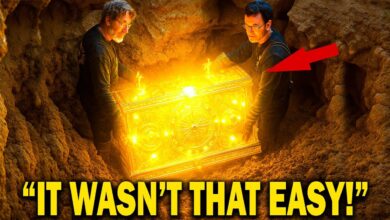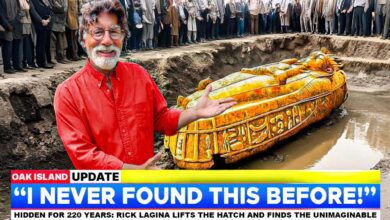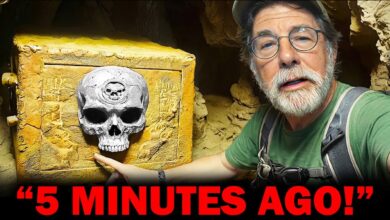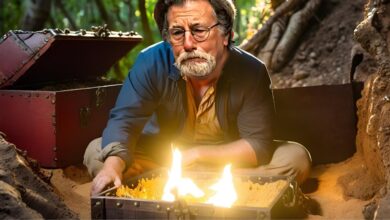The Curse of Oak Island: HUGE DISCOVERY Proves Gold is Near (Season 12)
The Curse of Oak Island: HUGE DISCOVERY Proves Gold is Near (Season 12)

MARTY:
Gentlemen, here we go.
Another season. Another attempt.
We’ve come a long way
and opened up
a lot of possibilities.
After all these years,
we’re still together,
still passionately committed
to finding answers
to what I have always believed
since we were little kids
and the story
that is Oak Island,
the magic that is Oak Island.
NARRATOR:
A new year of digging
into the ground–
as well as history– is about
to begin on Oak Island
for brothers Rick
and Marty Lagina and their team.
I’m all in. I want to throw
everything we’ve got at it.
It begins… now.
-It’s a pretty
exciting day here.
-Yeah.
NARRATOR:
…Craig Tester
and surveyor Steve Guptill
join Alex Lagina
and other members of the team
where a large-scale excavation
is about to begin in the hope
of uncovering Shaft Two,
a 110-foot-deep structure
that was dug in 1805,
just 14 feet southeast
of the original Money Pit.
We’re digging up the first ever
-searcher shaft on Oak Island.
-True.
-True.
-Well, we think.
-That we know of.
-ALEX: Yeah.
(chuckles)
That’s right.
So the big goal is to get
good, solid pieces of the shaft
so we can do
dendrochronology on it.
That’ll give us
an excellent date.
If anything’s gonna tie
to the original Money Pit,
it’s gonna be Shaft Two.
NARRATOR:
Dendrochronology is
a revolutionary testing method
whereby tree rings are
analyzed in wood samples
to determine the exact year
a tree was cut down
for use in construction.
If the team is able
to uncover what they believe
to be Shaft Two and confirm
it dates to approximately 1805,
it could help them locate
the original Money Pit
and also pinpoint
the source of precious metals
that the team has detected
in the area.
Lot of smaller rocks in there
right now.
ALEX:
There you go.
That’s a big piece of wood
in the side there.
Look at that profile.
Oh, look at that.
SCOTT:
That’s awesome right there.
Look at that.
ALEX: So that’s what
we’re probably looking at
-is one of the long walls.
-Correct.
The big question is,
is it Shaft Two or not?
RICK:
Shaft Two is almost
like the Holy Grail,
other than finding
the original Money Pit.
Can you pick up that big piece?
The big piece? Yeah.
RICK:
If we can prove
definitively that this
supposed Shaft Two is
really Shaft Two,
the Money Pit should be
somewhere in close proximity.
-CRAIG: Wow.
-SCOTT: I like that.
Look how thick that sucker is.
ALEX:
Yeah.
Why…?
-This…
-ALEX: That’s rounded.
That is rounded.
So this should be
the outside of the tree.
No, this may be
excellent for dendro.
Definitely would like
to get more though.
Yeah. I like that.
CRAIG:
We want to try to get pieces
that look like they have
a lot of tree rings on it
so we can date it
by dendrochronology.
And we need
multiple samples from here.
-Hey.
-ALEX: Hey.
-CRAIG: Marty.
MARTY:
Look at that.
Looks like you got
the shaft wall, eh?
STEVE:
Yep.
It’s another piece
in the puzzle, you know?
ALEX:
Can you see what
the far wall’s made of there?
Not really.
Why don’t you grab the mirror?
-ALEX: Yeah.
-CRAIG: We’ll do that.
SCOTT:
We want to keep our dig
going deeper.
We’re using a mirror
to try to shine some light
down there so we can see
to examine this shaft.
Right there?
There you go.
-Yeah.
-CRAIG: There it is.
Now you can see it going across.
-MARTY: So, is that
the corner then?
-That’s the corner.
MARTY:
The thing that comes
to mind immediately
whenever we
unearth these shafts,
what people did here
without technology,
that’s the first thing, always,
when you unearth these things.
Then you think, “Okay,
what does this mean to us?”
If we find Shaft Two,
we know we have 14 feet
to the Money Pit.
That’s not a great distance.
-Billy.
-Yep.
Reposition the excavator here.
Do a cross-section
along that end,
-try and find the other wall.
-Right.
We’ll get our dimensions.
CRAIG:
Well, hopefully,
he can find
the far end of this shaft.
(metal detector beeping)
Ooh, I’ve got a signal, Rick.
Hang on, Billy. I got a signal.
(beeping)
Oh, ho!
Look at this, Rick.
Oh, that’s a beauty. Look.
-A rose-head spike.
-Yep.
GARY:
It’s an oldie, as well.
Look at the condition of that.
-RICK: What years?
-GARY: Yeah, I mean,
a spike like this, 1700s.
Well, it lines up
with the possibility
that that’s Shaft Two.
NARRATOR:
A rose-head spike?
Between the 1780s and 1840s,
hand-forged iron spikes
were created for construction,
which featured
crudely hammered heads
resembling the petals of roses.
Could this iron fastener
be another important clue
that may help verify
that the team
has located Shaft Two?
See where the darker area?
MARTY:
Yeah.
There’s a whole bunch
of boards in there.
Yup. And blacker
usually looks older.
RICK:
Ooh, yeah.
Okay, what do you want to do?
So, Scott’s gonna guide Billy,
and we’re just gonna try
to nick that off the wall.
SCOTT (on radio):
Okay, Billy.
We’ll try and grab the side
of those beams.
RICK:
Looking at the bottom,
you can see much older wood.
Shaft Two was created in 1805.
So, the hope is
that we can get a wood sample
that will date
to that period of time,
and bingo, we have the first
discovery shaft on Oak Island.
So, it’s incredibly important.
Now, pull… pull your bucket
forward a little bit.
STEVE:
That looks like our beam.
Go straight down with your boom.
You got it.
SCOTT (on radio):
It’s perfect. Oh.
It fell out of the bucket.
MARTY:
When you get a hole 40 feet deep
with vertical sides,
it’s challenging
for the equipment operator.
Billy’s really good, but
he cannot see
where that bucket is.
SCOTT (over radio):
There. It’s tipped back
into your bucket.
Bring it on up.
MARTY:
It’s like a very large,
very expensive variation of
the little grabber video games.
-That’s a monstrous beam.
Look at that.
-Yeah.
It’s huge!
-Watch your feet.
-Yup.
MARTY:
That’s a good piece.
GARY:
All right. Let’s see
if there’s any metal in there.
-MARTY: Yes.
-(beeping)
No metal in there.
That is a good sign.
No fasteners,
maybe an older style
of construction.
Yes.
NARRATOR:
Possible older wooden beams
some 40 feet deep
in the mysterious shaft?
Could that suggest
that someone reconstructed
the top portion of Shaft Two
after it was first built
in 1805?
Although it will take
several weeks
for dendrochronology testing
to be conducted
on the wood samples
that they have recovered,
the team may have finally
obtained the evidence
that they need to locate
the original Money Pit.
STEVE:
So, I mean,
if this is Shaft Two, we know
we’re 14 feet away
from the Money Pit,
so, it’s a landmark for us.
RICK:
We’ve succeeded
in what we intended to do.
We’ve got a proper sample
at depth.
We can send that off for dendro,
move seamlessly forward
with the drill program
in the pie-shaped area.
Look, we wanted proof that this
may or may not be







